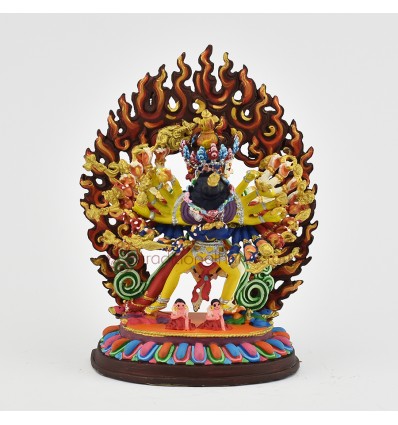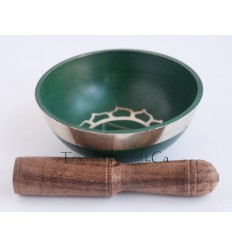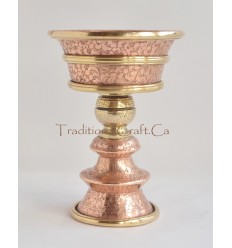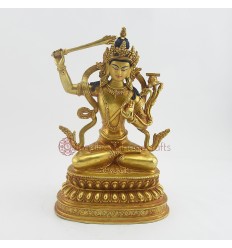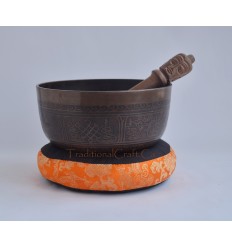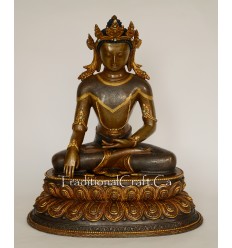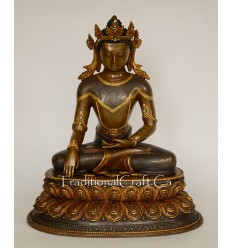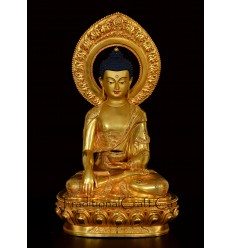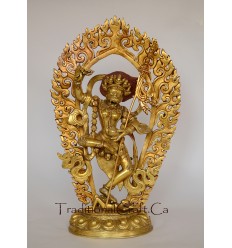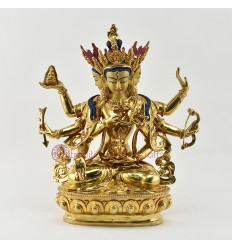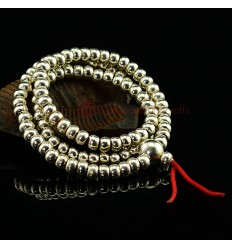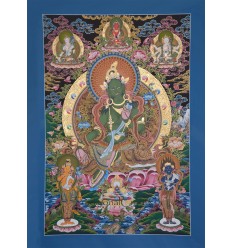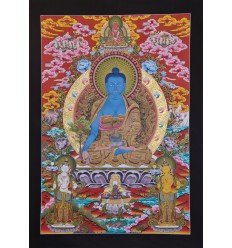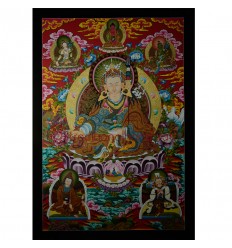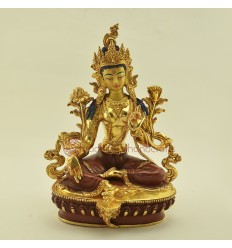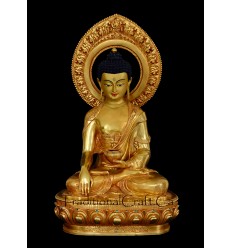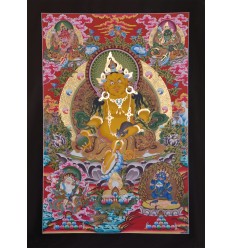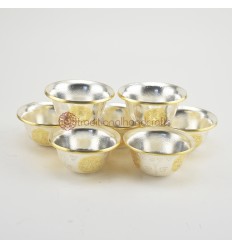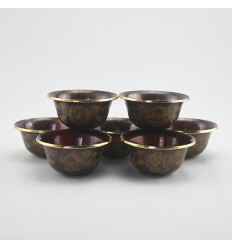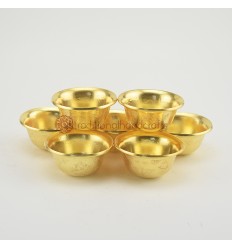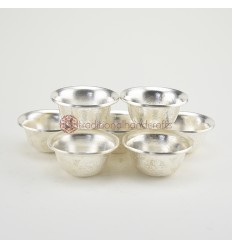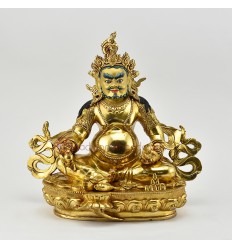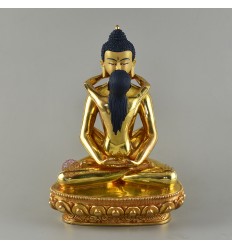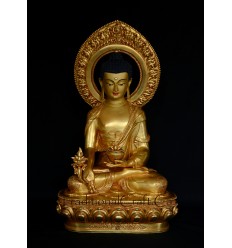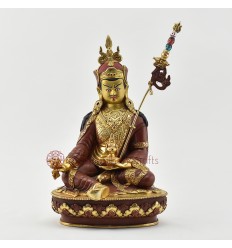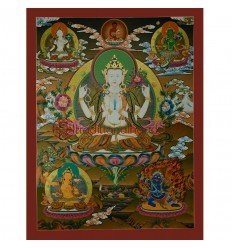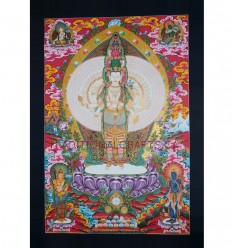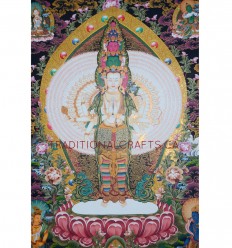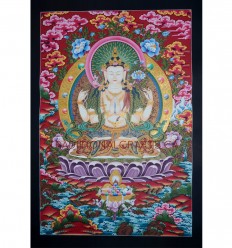No products
Product successfully added to your shopping cart
There are 0 items in your cart. There is 1 item in your cart.
Fine Quality Copper Alloy with Beautifully Hand Painted Chakrasamvara Statue
761768127322
New
Traditional Hand Crafted Tibetan Buddhist Copper Alloy with Beautifully Hand Painted Chakrasamvara Statue Rupa Shrine | Altar Monastry Shrine | Altar Monastry From Patan, Nepal
1 Item
Warning: Last items in stock!
Chakrasamvara Statue
|
Name |
Chakrasamvara – Vajravarahi Statue |
|
Height |
5.5” with frame |
|
Height |
4.25” without frame |
|
Width |
4” |
|
Depth |
2.25” |
|
Material |
Lost Wax Method, Copper Alloy with Beautifully Hand Painted |
|
Actual Weight |
0.468 Kg. |
|
Ships From |
Patan, Nepal |
|
Shipping Provider |
Express Shipping Service |
|
Shipping Time |
Usually ships within 48 hours. Allow 5 – 7 business days for delivery worldwide. |
|
Insurance |
Insurance is included in the shipping cost. |
Chakrasamvara – Vajravarahi – Supreme Bliss
Chakrasamvara, also called Heruka, embraces his consort Vajravarahi passionately. Chakrasamvara represents bliss and Vajravarahi represents emptiness; together they symbolize the indivisible union of bliss and emptiness and express the perfect balance of enlightenment. Chakrasamvara's practices are believed to have many special qualities and quickly bring powerful blessings and accomplishments. The instructions for this Tantric path were first taught in the Root Tantra of Heruka by Buddha Vajradhara.
Gestures and Attributes
Chakrasamvara is depicted in his four-headed, twelve-armed form; his body is the manifestation of omniscient wisdom, clearly indicated by his three eyes, symbolizing knowledge of past, present, and future. Chakrasamvara’ s outstretched right leg treads on the breast of red Kalarati, the principal worldly goddess. His bent left leg treads upon black Bhairabha, the principal worldly god. Chakrasamvara treads on Kalarati and Bhairabha to show that he has abandoned the two extremes of existence and non-existence, and the two extremes of samsara and nirvana. His abandonment of nirvana in order to work for the benefit of sentient beings demonstrates his boundless great compassion.
Chakrasamvara's twelve arms indicate that he has abandoned the cycle of the twelve dependent-related links - that is, samsara. His first two arms embrace Vajravarahi with his left hand holding a bell, representing wisdom, and his right hand holding a Vajra, representing skillful means. His next two hands hold a white elephant skin stretched across his back, showing that he has abandoned the ignorance of self-grasping. His third right-hand holds a Damaru, the fourth an axe, the fifth a curved knife, and the sixth an upright three-pointed spear. His third left hand holds a Khatvanga marked with a Vajra, the fourth a skull cup brimming with blood, the fifth a Vajra noose, and the sixth a four-faced head of Brahma.
The sound of the Damaru invokes all Buddhas to bless sentient beings. The axe represents the abandonment of all faults of body, speech, and mind. The curved knife is used to cut the root of delusion: grasping at extremes. The three-pointed spear symbolizes abandoning the imprints of delusions of the three realms. The Khatvanga represents Chakrasamvara's ultimate Bodhichitta, and the skull cup filled with blood symbolizes his realization of emptiness with a mind of spontaneous great bliss. The Vajra noose indicates that his mind is always bound by bliss, and the four-faced severed head of Brahma, held in Chakrasamvara's left "wisdom" hand, symbolizes both his severance of all conceptions, and his development of altruism through the four immeasurable of compassion, love, sympathetic joy, and equanimity.
Chakrasamvara's four faces show that emptiness can be realized by meditating on the four doors of perfect liberation. Each of Chakrasamvara's heads is adorned with a crown of five human skulls. His hair is done up in a topknot and on the left side is a half-moon, slightly tilted. His topknot is surmounted by a gleaming nine-faceted jewel. He wears a lower garment of a tiger skin, representing his abandonment of hatred, and a long necklace of fifty shrunken moist human heads, which indicate his abandonment of ordinary appearances and conceptions. He is adorned with a variety of bone ornaments, including earrings, necklaces, bracelets, and anklets, accentuating his divine presence with intricate and symbolic adornments.
He displays nine moods. The three physical moods of majesty, heroism, and menace are expressed by his body maintaining an air of majesty, his feet treading on Bhairabha and Kalarati, and the frown at the center of his brow. The three verbal moods of laughter, truth, and ferocity are expressed by the slight smile on his lips, his bared teeth, and his tongue curled back. The three mental moods of compassion, attentiveness, and serenity, are expressed by his long almond-shaped eyes, his wide-open eyes, and his looking at Vajravarahi from the corner of his eyes.
Vajravarahi is naked with freely hanging hair and wears a lower garment made from fragments of a skull. Her left hand, embracing Chakrasamvara's neck, holds a skull cup brimming with the blood of the four maras. Her right hand in the threatening mudra brandishes a curved knife, opposing the malignant forces of the ten directions. Her body shines with a brilliance like that of a fire at the end of an aeon. Her two legs are clasped around Chakrasamvara's thighs. She is the nature of blissful great compassion. She wears a crown of five human skulls and a necklace of fifty human skulls. Chakrasamvara and Vajravarahi abide in the center of a fiercely blazing fire of exalted wisdom, and they are supported by a lotus representing the complete purity of body, speech, and mind.
About this Sculpture
This sculpture is a beautiful representation of Chakrasamvara and Vajravarahi in union showcasing a stunning representation of divine harmony. Crafted from copper alloy using the lost wax method, the statue stands as a testament to exquisite artistry. The fine carving, both by hand and through the delicate touch of the artisan, reveals remarkable detailing in both Chakrasamvara and his consort, Vajravarahi. The artisan's meticulous work not only skillfully captures the carving details of the statue but also, through hand-painted touches, breathes life into the artwork, enhancing its overall beauty and vibrancy.This sculpture was individually handcrafted in Patan, Nepal by master artisans of the Shakya clan who are considered among the best in the world. These craftsmen are the modern heirs to a centuries-old tradition of creating sacred art for use in temples and monasteries. The fine metalworking techniques have been passed down from generation to generation since ancient times.
No customer comments for the moment.


